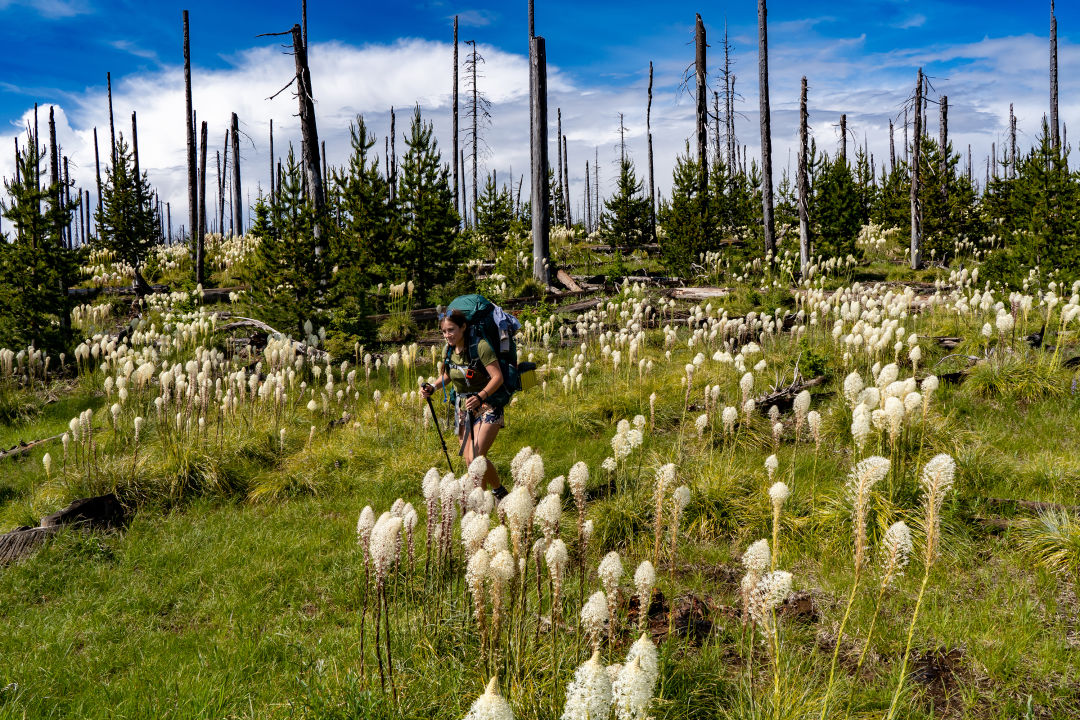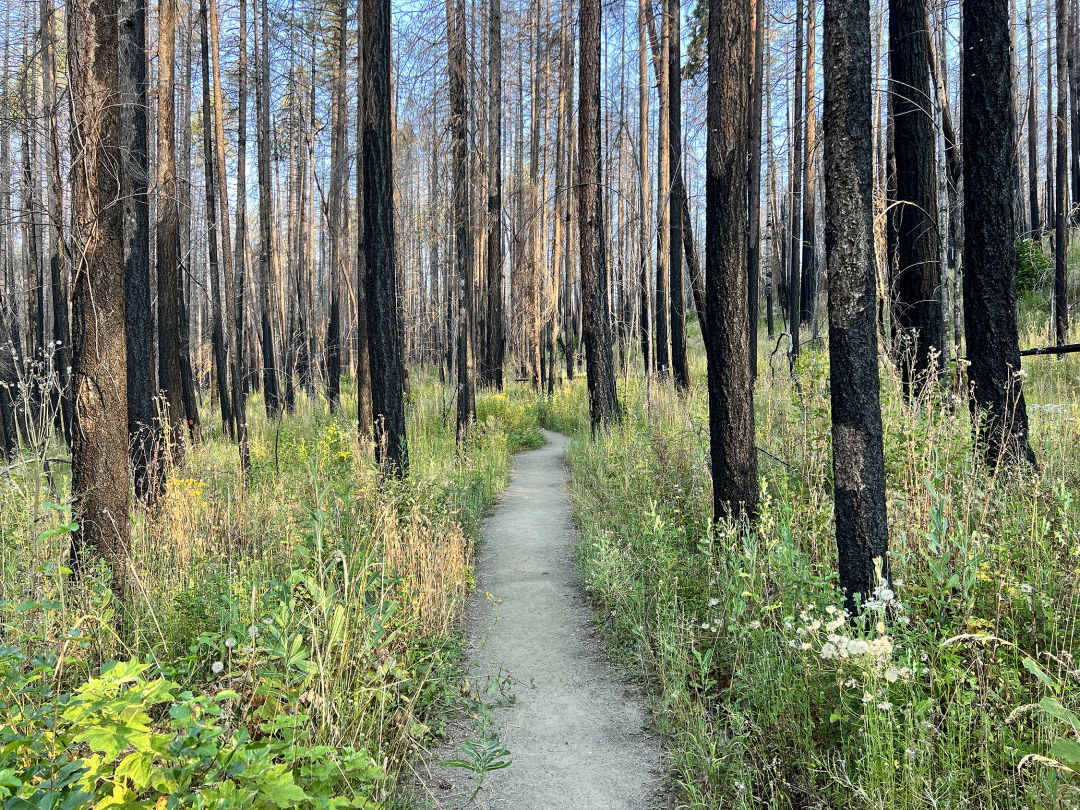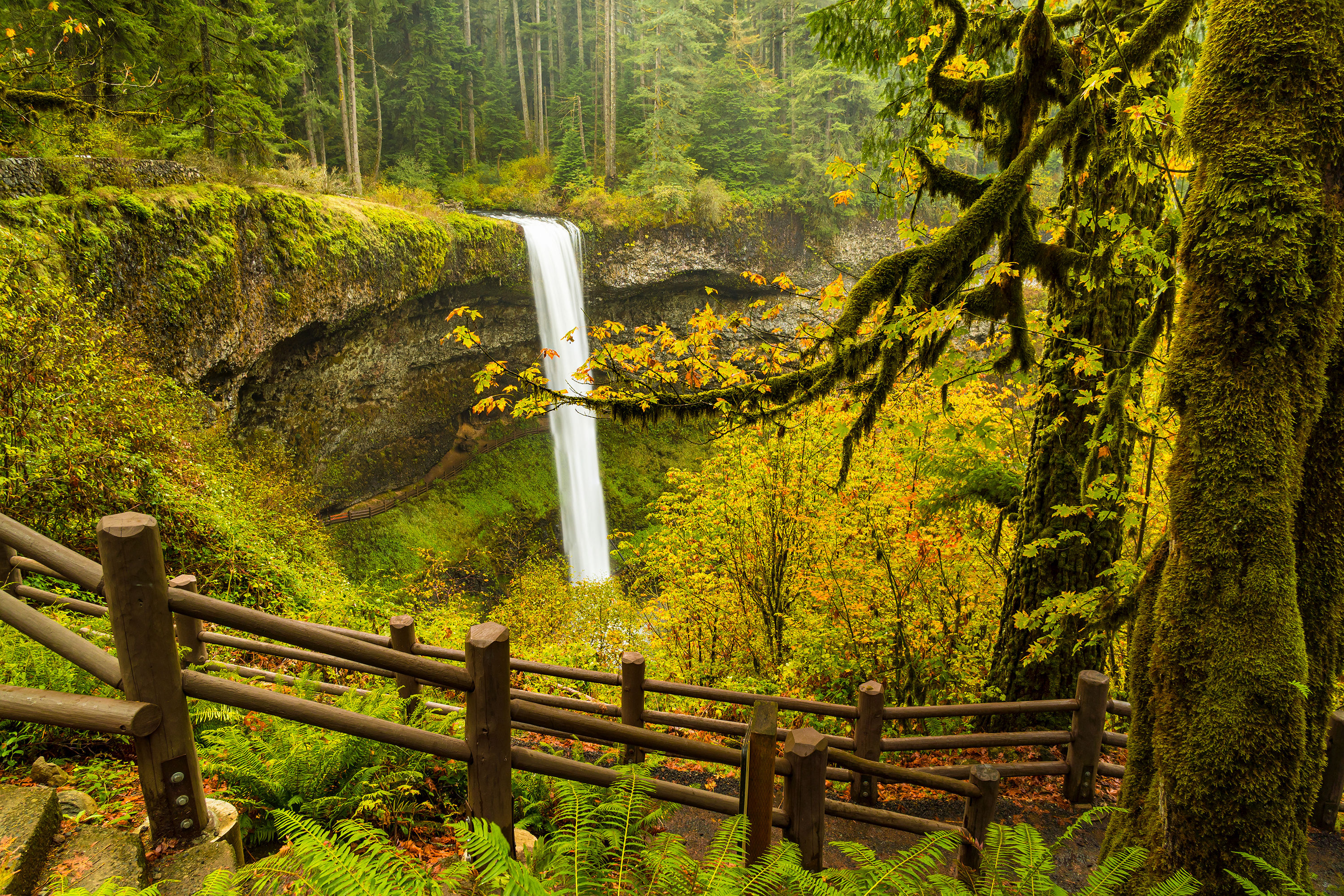Why You Should Visit Wildfire-Burned Forests This Summer

Backpackers on the PCT surrounded by Xerophyllum tenax (Bear Grass), growing among dead trees in Santiam Pass, OR.
In July 2018, I set out on my first Columbia River Gorge hike since the Eagle Creek Fire burned the previous year through nearly 50,000 acres of pristine forest—an area half the size of Portland.
My destination was Dry Creek Falls, a short jaunt from Cascade Locks via the Pacific Crest Trail near where the fire had started 10 months earlier. I went into the hike with mixed feelings—excited to see the trail’s namesake waterfall, but fully expecting a dystopian hellscape of downed snags, ash-covered hillsides, and charred shrubs.
So, imagine my surprise when I encountered not a dying thicket in decay, but a new forest enjoying all the telltale signs of a bountiful rebirth: colorful wildflower displays, bushy undergrowth, black-billed woodpeckers drilling new cavities in dead trees, and joyous songbirds building nests among the snags.
I finished that hike not only enchanted by Dry Creek Falls but brimming with a newfound appreciation for the hidden beauty of a forest at that particular stage of its lifecycle. Perhaps it was the copium speaking, but I walked into a barren landscape scarred by devastation and walked out of a resilient forest blossoming anew. Heather Ibsen, public affairs officer for the Mt. Hood National Forest, recently put that feeling into perspective: “A fire on the landscape is not inherently all positive or all negative; it just creates this different state in nature's progression. So, there are some short-term and long-term winners and losers—but it's just change, right?”
Put another way: Climate change is causing longer, dryer, hotter summers—conditions in which wildfires will continue to thrive for years to come. Rather than swear off these changing forests, maybe it’s time to embrace their gifts. Here’s how to find a new kind of beauty in these dramatic landscapes this summer and beyond.

Image: Courtesy Matt Wastradowski
What makes a wildfire-scarred forest so special?
It’s easy to think that wildfire destroys a forest, forever and irrevocably. But John Bailey, a forest scientist with Oregon State University, says that fire is just one part of a centuries-long lifecycle. “Fire comes and goes and is a natural thing, just like fog and rain and snow,” he says. In other words, fire doesn’t destroy a forest—it just changes it, as it has for thousands of years and will continue doing for thousands more.
And at this specific stage in a forest’s growth and evolution, those charred stands offer gifts for anyone willing to seek them out—gifts that can’t be unwrapped in more mature, old-growth forests. Here’s why you should peek at what you'll only see in burned forests.
The damage (likely) isn’t as bad as you think: Years ago, I assumed that wildfires wrecked entire forests—Bailey explains that fires typically burn in mosaic-like patterns, so the damage is rarely all-encompassing; hikers may dart between burned stands and untouched foliage several times on a given trail—enjoying a glimpse into a forest’s disparate life cycles. Chad Atwood, forest silviculturist with the Mt. Hood National Forest, appreciates that diversity in burned areas. “There are large continuous patches of trees that are still alive and still magnificent, but then you can walk into a burned meadow and it's so green and everything is coming back,” he says.
Technicolor wildflower blooms abound: Wildfire leaves behind a thinned-out canopy, which makes it easier for rainfall and sunlight to reach the ground—warming it up and creating ideal conditions for dramatic wildflower blooms. A hike to the summit of the Wahkeena Falls-Multnomah Falls Loop in the Gorge, for instance, reveals white fairy bells, orange and brown tiger lilies, and myriad other wildflowers in the sunnier stands where trees fell or were cut after the 2017 Eagle Creek Fire.
Wildlife sightings may increase: Wildfire brings a variety of animals that might not have previously lived in an area—or that hadn’t been quite as visible before. Roosevelt elk, for instance, love the easy access to ground-level leaves on toppled trees, and according to Atwood, are easier to spot on once-forested hillsides along the Clackamas River. And new to the Clackamas River gorge are peregrine falcons, which have an easier time hunting squirrels, insects, and mice in sparse, post-wildfire forests.
New vistas and viewpoints open up: In the ultimate example of making lemonade, burned forests can reveal views and vistas that once hid behind forest canopies. Bailey says that the B&B Complex fires—which burned in 2003 around Mount Washington and Mount Jefferson in the Cascades—changed his cross-country skiing experience for the better. "It's actually a spectacular skiing spot now because of the post-fire views and how much has been opened up."
You’ll (likely) enjoy a bit more solitude: Whether most of us don’t know that forests have reopened or we’re not interested in seeing the damage, wildfire-scarred forests tend to attract fewer crowds—typically when fewer trails, campgrounds, and other recreation areas are open in the vicinity. The Gorge might be as busy as ever, but other burned forests are still recovering (more on that later) and, as such, promise a quieter experience where you’ll hear more woodpeckers than people.

Image: Courtesy Matt Wastradowski
What to know about visiting a burned forest
For all their beauty, recovering forests present a few dangers and complexities that aren’t present in more developed areas. Here’s how to prepare, stay safe, and have fun.
Respect all closures: First and foremost, know which parts of a burned forest are closed, and act accordingly. These areas are closed for good reason—usually due to falling rocks, hazardous trees, or possible landslides—and those trespassing can face fines and even jail time. As if that weren’t enough of a deterrent: If something goes wrong in closed-off areas, search-and-rescue operations might be limited due to hazardous conditions.
Know what’s open: Before heading out, consult with the appropriate land manager (such as the U.S. Forest Service for trails in the Columbia River Gorge and on Mount Hood) to see what’s open and what hazards to consider; if a desired trail or campground is closed, chances are good a friendly ranger may offer a recommendation of an under-the-radar alternative that’s actually open—one that checks many of the same boxes as your desired destination.
Prepare for a lack of facilities: Replacing drinking fountains and restrooms is almost never at the top of a land manager’s to-do list following a fire; bring plenty of water, and have a plan for when nature calls and a restroom isn’t immediately available. Cell phone towers might not be installed yet, either, limiting service—so let someone know where you’re going and when you plan to be back.
Watch for potential hazards: Once on the trail or at your campground, stay alert and mindful of the hazards you may encounter—including loose rocks, downed trees, rockfall, or mudslides caused by recent rain.
Where to visit burned forests this summer and beyond
If you’re now convinced of the beauty and exploration to be found in recovering forests, here are a few suggestions for experiencing these areas around Oregon.
Columbia River Gorge: The most obvious choice for Portlanders is the Columbia River Gorge, where nearly 50,000 acres burned in September and October 2017. Most of the Gorge has reopened in recent years; a few fun trails include the Eagle Creek trail to Punch Bowl Falls (a 4.2-mile round-trip hike with about 500 feet of elevation gain) and the Pacific Crest Trail to Dry Creek Falls (a 4.5-mile round-trip hike with more than 700 feet of elevation gain). For overnight ideas, consider pitching a tent in the Eagle Creek Campground.
Mt. Hood National Forest: In 2020, the human-caused Riverside Fire burned nearly 140,000 acres, mostly along the Clackamas River in the Mt. Hood National Forest. Three years later, visitors can drive along Highway 224 into the heart of the burned forest—where some boat access sites and a few day-use areas are currently open. Ibsen says the fire unlocked previously hidden views—like the snow-capped peak of Mount Jefferson and a herd of mountain goats on the slopes of Olallie Butte. “There are these new vistas and opportunities out there,” she says. “The visibility up that road and going around those turns is just really quite incredible.”
Sky Lakes Wilderness: A trio of lake basins, collectively known as the Sky Lakes Wilderness, cover the crest of the Cascade Range about one hour west of Klamath Falls in Southern Oregon. Hike through the aftermath of a lightning-caused wildfire that burned about 5,000 acres in 2017, along the Sky Lakes Loop (which measures up to 14.5 miles and features up to 1,600 feet of elevation gain—although the trip can easily be shortened); beyond the charred snags and summertime wildflower displays, the hike heads past several alpine lakes noted for their clarity and purity.
Highway of Waterfalls: In 2021, the Jack Fire burned nearly 25,000 acres along Oregon Route 138—popularly known as the “Highway of Waterfalls” for its close proximity and easy access afforded to more than a half-dozen cascades along the North Umpqua River. Two years later, colorful wildflower displays bloom among scorched trees—and (at least in the case of Susan Creek Falls) more expansive views of the region’s signature waterfalls abound.
McKenzie River: In the summer and fall of 2020, the Holiday Farm Fire burned nearly 175,000 acres along the McKenzie River in the Cascade foothills. Impacted communities continue to rebuild today, and recreation opportunities are numerous: Mountain bikers love the demanding O'Leary Trail Complex; campers enjoy spending a night under the stars at the sun-kissed Lookout Campground; and hikers still have their choice of trails, including the Tamolitch Falls (Blue Pool) trek, the always-popular Sahalie and Koosah Falls loop, and the trail to Terwilliger (Cougar) Hot Springs—a tiered series of clothing-optional springs that was remarkably spared in the fire.




